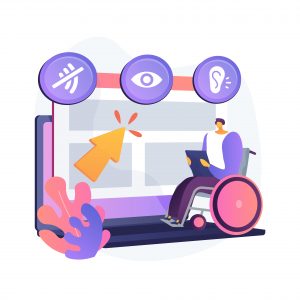
In today’s digital age, it’s crucial for businesses and website owners to prioritize accessibility in their web design. Accessibility refers to the practice of making websites usable and navigable for people with disabilities. By designing inclusive websites, we can ensure that all users, regardless of their abilities, can access and engage with online content. In this article, we will explore the significance of accessibility in web design and provide practical tips backed by data and statistics for creating inclusive websites that cater to a diverse range of users.
Understanding Accessibility
Web accessibility aims to remove barriers that prevent people with disabilities from effectively using websites. Disabilities can encompass various categories, including visual impairments, hearing impairments, mobility limitations, cognitive disabilities, and more. It’s essential to consider the needs of these users during the design process to ensure equal access and usability for everyone.
Adhering to Web Content Accessibility Guidelines (WCAG)
The Web Content Accessibility Guidelines (WCAG) developed by the World Wide Web Consortium (W3C) are globally recognized standards for web accessibility. According to a study conducted by WebAIM, an organization focused on web accessibility, 98.1% of home pages analyzed had at least one WCAG 2.0 failure. By adhering to these guidelines, you can ensure that your website meets the standards required for accessibility and stands out among the majority of websites that fall short.
Implementing Alternative Text (Alt Text) for Images
Alt text provides a textual description of images on a website. It is crucial for individuals with visual impairments who rely on screen readers to understand the content. According to the WebAIM Million analysis, alt text was missing or inadequate in 66.6% of images. By adding descriptive alt text to images, you enable these users to comprehend the visual context of your website and avoid excluding a significant portion of your potential audience.
Providing Clear and Structured Headings
Clear and structured headings not only improve the overall organization of your content but also assist users who rely on screen readers or those who navigate websites using the keyboard. According to a study conducted by Nielsen Norman Group, 70% of users skim web pages rather than reading them in detail. Properly marked-up headings create a logical hierarchy and allow users to navigate through your website efficiently, facilitating both scanning and in-depth reading.
Ensuring Keyboard Accessibility
Some individuals with motor disabilities rely on keyboard navigation rather than a mouse. It is vital to ensure that all interactive elements on your website, such as links, buttons, and forms, can be accessed and operated using the keyboard alone. According to a survey conducted by WebAIM, keyboard accessibility was problematic in 76.9% of the cases analyzed. By prioritizing keyboard accessibility, you provide a seamless browsing experience for users with physical disabilities.
Color Contrast and Visual Design
Consider users with visual impairments or color vision deficiencies when choosing color combinations for your website. According to the World Health Organization (WHO), approximately 1.3 billion people worldwide live with some form of vision impairment. Ensuring sufficient color contrast between text and background colors is essential for making the content readable for everyone. Additionally, avoid relying solely on color to convey important information. Use additional visual cues such as icons or labels to provide clarity and improve comprehension for all users.
Providing Closed Captions and Transcripts for Videos
Videos are an integral part of many websites, but they can present challenges for users with hearing impairments. According to a report by the World Federation of the Deaf, there are over 466 million people worldwide with disabling hearing loss. By providing closed captions and transcripts for videos, you make the content accessible to everyone. These features enable individuals who are deaf or hard of hearing to understand the audio content of your videos, creating a more inclusive experience.
Testing and User Feedback
Regularly test your website’s accessibility features and gather feedback from users with disabilities. Conduct usability testing sessions with individuals who have diverse accessibility needs to identify any barriers or usability issues. According to the W3C, incorporating accessibility into user testing can uncover 35% more usability problems than traditional testing methods. Their insights and feedback can help you make necessary improvements and ensure a more inclusive user experience, ultimately leading to higher user satisfaction and engagement.
Designing websites with accessibility in mind is not only ethically sound but also makes good business sense. By creating inclusive websites, you expand your audience reach, improve user satisfaction, and demonstrate your commitment to equal access for all. Implementing the principles and techniques of accessibility, such as adhering to WCAG guidelines, providing alternative text, and ensuring keyboard accessibility, will enable you to design websites that are usable and enjoyable for a diverse range of users. By considering the data and statistics mentioned, we can see the significant impact that accessibility has on web design and the importance of creating a digital landscape that is inclusive and accessible to everyone.



